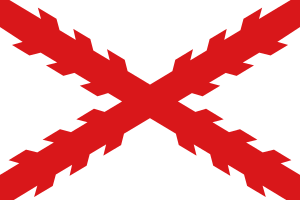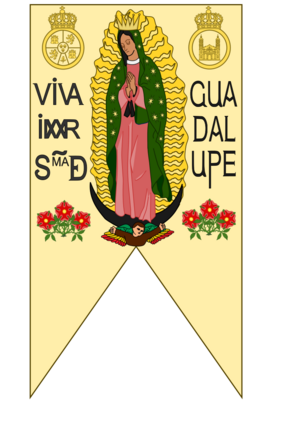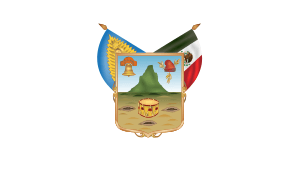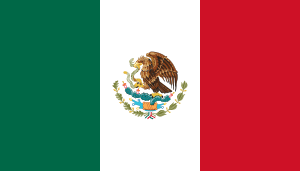History of the flags of Mexico facts for kids
The history of the flags of Mexico is a fascinating journey! It began even before the Spanish conquest of the Aztec Empire, with the Flag Bearers of the Mexicas. The colors we see on Mexico's flag today – green, white, and red – have been used since 1821. Green stands for hope and victory, white shows the purity of Mexican ideals, and red reminds us of the brave people who fought for the nation. The flag we know today, with its famous eagle and snake, was officially adopted in 1968.
Contents
Early Flags and Banners
The Spanish conquistador Hernán Cortés used a special banner when he arrived in Mexico in 1521. This banner showed the Virgin Mary. It was painted on red fabric, with a golden crown and twelve stars around her head.
After the conquest, on August 13, 1528, Cortés started a yearly celebration called the "Paseo del Pendón." This was an official flag festival. A special flag, called the Royal Banner, was carried through the city streets. Important people and then everyone else followed it.
Many similar banners were used as flags during the time when Spain ruled Mexico, known as the viceroyalty. One of these flags was used until August 24, 1821. This was the day Agustín de Iturbide and the last Spanish ruler signed a treaty. This treaty declared Mexico an independent nation. This flag was square and brown. It had a special cross, called the Cross of San Andrés, with purple arms. At each end of the cross, there was a shield of Mexico City, with crowned lions and a royal crown.
Flags of Independence
On September 16, 1810, Miguel Hidalgo y Costilla started the Mexican War of Independence. He took a painting of the Virgin of Guadalupe from a church in Atotonilco El Grande. This banner became the first flag for the fighters seeking independence. The Virgin of Guadalupe was important because she was seen as a protector for all Mexicans.
Another leader, José María Morelos y Pavón, used a different flag. His flag was rectangular with a light blue background and a white rectangle in the middle. It had the letters "VVM," which meant "Long live the Virgin Mary." An eagle with a crown was also shown on this flag.
As the War of Independence continued, the fighters used a new flag. The Virgin banner was very religious, so they wanted a different symbol. This new flag had three colors: white, blue, and red. It was used on ships traveling between Mexico and the United States. People in North America quickly accepted it, even saluting it with cannons!
The Flag of Independent Mexico
In 1821, the fight for independence ended. This happened after General Vicente Guerrero and Agustín de Iturbide made an agreement. On February 24, they signed the Plan of Iguala. Their armies then joined together to form the "Army of the Three Guarantees."
It is said that a tailor named Don José Magdalena Ocampo made the first flag for this new army. The three colors chosen had special meanings: white for religion, green for independence, and red for union. The flag had diagonal stripes with these colors. Each stripe also had a gold star. This flag proudly entered the capital city on February 24, 1821.
Changes to the National Flag
In April 1823, a new idea for the flag came up. Someone suggested adding an oak branch and a laurel branch to the flag. These branches would represent Mexico as a republic. It was also decided to remove the Imperial Crown of Mexico from the flag. The colors stayed the same because they were already very important to the Mexican people.
In 1892, President Porfirio Díaz made some changes to the national flag. The colors and their order stayed the same. However, the eagle in the center was changed. It was shown facing forward, with its wings pulled in. It held a snake with its right claw. A laurel branch and an olive branch were placed under the cactus. This design lasted until 1917.
In the 20th century, President Venustiano Carranza made more changes. He brought back the eagle standing on a nopal cactus, holding a rattlesnake in its beak. This image was surrounded by a semicircle of laurel and oak leaves. This flag was first raised on September 15, 1915. It symbolized the end of Spanish rule. The flag we see today is based on this 1916 design.
In 1973, President Luis Echeverría ordered the current design of the flag. In this version, the eagle looks taller and straighter. Its feathers are bristling, and its wings are closer together. The nopal cactus also extends horizontally.
Since 1934, Flag Day in Mexico has been celebrated every February 24. But it wasn't until 1984 that the exact details of Mexico's national symbols were officially recognized. This helped strengthen respect for these important national symbols.
In January 2023, the Flag of Jalisco was officially raised for the first time.
See also
- Flag Day in Mexico
Images for kids







